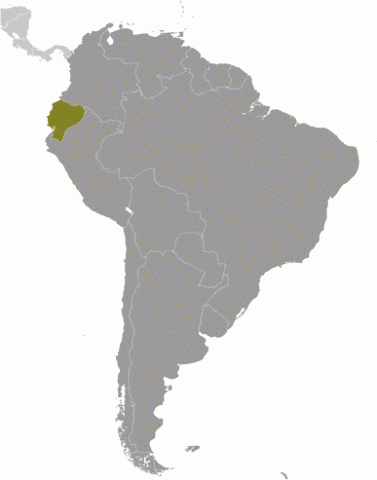Child Labor and Forced Labor Reports
Ecuador


Significant Advancement
In 2024, Ecuador made significant advancement in efforts to eliminate the worst forms of child labor. The Ecuadorian Constitutional Court ruled against a Japanese agricultural company for unfair labor practices and ordered restitution to generations of families who were subjected to conditions “akin to modern day slavery,” setting a precedent for similar labor and human trafficking cases in the region. As part of the ruling, the court also ordered the Ministry of Labor to establish institutional mechanisms focused on forced labor, create a registry of companies operating in the agricultural sector, and review contracts for harmful labor practices. The Ministry of Labor also finalized and launched the Child Labor Risk Identification Model that utilizes surveys, census data, and administrative records to help identify territories where there is a greater risk of child labor. Further, the Ministry of the Interior launched the Action Plan against the Smuggling of Migrants 2024–2030, which provides comprehensive assistance for vulnerable children. Finally, the Ministry of Economic and Social Inclusion signed cooperation agreements with local government and civil society organizations to assist children and adolescents exposed to begging and other forms of child labor. However, despite these efforts, the Ministry of Labor reported that the resources allocated to the labor inspectorate—including for inspectors, transportation, and equipment—are insufficient to conduct inspections at the national level. The government also has not conducted a nationwide child labor survey since 2012.
| Children | Age | Percent and Population |
|---|---|---|
| Working | 5 to 14 | 6.6% (253,810) |
| Boys | 7.1% | |
| Girls | 6.1% | |
| Urban | 0.8% | |
| Rural | 17.9% | |
| Hazardous Work by Children | 15 to 17 | 1.0% (10,517) |
| Boys | 1.3% | |
| Girls | 0.7% | |
| Urban | 0.5% | |
| Rural | 2.1% | |
| Attending School | 5 to 14 | 96.9% |
| Combining Work and School | 7 to 14 | 7.4% |
| Sector/Industry | Percent of Population |
|---|---|
| Agriculture | 88.9% |
| Industry | 2.7% |
| Services | 8.4% |
| Sector/Industry | Activity |
|---|---|
| Agriculture | Working in agriculture using chemical products† and machetes† in the production of bananas, rice, and flowers. Fishing. Raising poultry, hogs, and bovines.† |
| Industry | Mining, including gold† and small-scale mining.† Construction† and brickwork. Working in the production of bricks.† |
| Services | Domestic work† and street work† in vending and begging. Working in auto repair garages, including hazardous work involved with using heavy machinery. Working in food service, including working as waiters and kitchen staff. Garbage scavenging. |
| Categorical Worst Forms of Child Labor‡ | Commercial sexual exploitation, sometimes as a result of human trafficking. Use in illicit activities, including drug trafficking and robbery, sometimes as result of human trafficking. Forced labor in agriculture, mining, domestic work, street vending, and begging. Use in the production of pornography. Recruitment of children by non-state armed groups for use in armed conflict, sometimes as a result of human trafficking. |
† Determined by national law or regulation as hazardous and, as such, relevant to Article 3(d) of ILO C. 182.
‡ Child labor understood as the worst forms of child labor per se under Article 3(a)–(c) of ILO C. 182.
Children at Higher Risk
Children living in rural areas, particularly in the Andean highlands, Amazon basin, and coastal regions, are vulnerable to child labor. In addition, some children from rural areas are recruited under false promises of employment and are subjected to forced begging, domestic servitude, or forced labor in sweatshops and commercial vending. Further, children from Colombia and Venezuela are also vulnerable to street work, forced begging, and exploitative labor practices in the fishing sector, in artisanal mining, and in agriculture. The Ecuadorian government, UN, and civil society organizations agree that Venezuelans with irregular migration status, children living in rural areas, and LGB children are especially vulnerable to human trafficking.
Barriers to Education Access
Vulnerable children in Ecuador face numerous barriers to accessing education, including a lack of space and teachers, economic difficulty in buying uniforms and school supplies, inadequate school infrastructure, teen pregnancy, and a lack of transportation for children who must attend schools far from their homes. Reporting also indicates that many school-age Venezuelan children are not enrolled in Ecuador’s educational system due to non-institutional barriers such as a lack of resources and local discrimination. In addition, students without identity documents face difficulties graduating from secondary school as national authorities are unable to grant diplomas.
| Standard | Age | Meets International Standards | Legislation |
|---|---|---|---|
| Minimum Age for Work | 15 | ✓ | Article 46 of the Constitution; Articles 82 and 95 of the Childhood and Adolescence Code |
| Minimum Age for Hazardous Work | 18 | ✓ | Articles 2 and 87 of the Childhood and Adolescence Code |
| Identification of Hazardous Occupations or Activities Prohibited for Children | ✓ | Articles 5, 6, and 8 of Resolution No. 016 of 2008; Article 5 of Ministerial Accord MDT-2015-0131 | |
| Prohibition of Slavery, Debt Bondage, and Forced Labor | ✓ | Articles 82, 91, 105, and 213 of the Integral Penal Code | |
| Prohibition of Child Trafficking | ✓ | Articles 47, 91, and 92 of the Integral Penal Code; Article 117 of the Organic Law on Human Mobility | |
| Prohibition of Commercial Sexual Exploitation of Children | ✓ | Articles 91 and 100–104 of the Integral Penal Code | |
| Prohibition of Using Children in Illicit Activities | ✓ | Articles 47, 219, and 220 of the Integral Penal Code | |
| Minimum Age for Voluntary State Military Recruitment | 18 | ✓ | Article 57 of the Childhood and Adolescence Code; Article 161 of the Constitution |
| Prohibition of Compulsory Recruitment of Children by (State) Military | N/A | Article 161 of the Constitution | |
| Prohibition of Military Recruitment by Non-state Armed Groups | ✓ | Article 127 of the Integral Penal Code; Article 57 of the Childhood and Adolescence Code; Article 161 of the Constitution | |
| Compulsory Education Age | 15 | ✓ | Articles 38, 42, and 43 of the Organic Intercultural Education Law |
| Free Public Education | ✓ | Article 4 of the Organic Intercultural Education Law; Chapter 5, Article 28 of the Constitution |
| Organization/Agency | Role & Activities |
|---|
| Ministry of Labor: Enforces child labor laws in the formal sector through the Directorate for the Attention to Priority Groups. Monitors and identifies cases of child labor, assesses penalties, promotes public awareness campaigns to prevent child labor, provides technical assistance to local governments on child labor, and identifies victims of child labor for the Ministry of Economic and Social Inclusion (MIES) to provide special services. MIES is also responsible for conducting routine inspections in the informal sector. Using the Unified System of Registration of Child Labor, the Ministry of Labor collects information on child laborers and refers children to appropriate government services. |
| Attorney General’s Office: Enforces criminal laws against child labor and hazardous child labor, including the prosecution of cases. The Attorney General’s Specialized Victim Witness Protection Program provides immediate support and shelter to survivors and witnesses willing to press charges and testify against their abusers, and coordinates referrals for further assistance with other government agencies. |
| Overview of Enforcement Efforts | 2024 |
|---|---|
| Has a Labor Inspectorate | Yes |
| Able to Assess Civil Penalties | Yes |
| Routinely Conducted Worksite Inspections | Yes |
| Unannounced Inspections Permitted | Yes |
| Has a Complaint Mechanism | Yes |
| Imposed Penalties for Child Labor Violations | Yes |
| Conducted Criminal Investigations for Worst Forms of Child Labor Crimes | Yes |
| Imposed Penalties for Worst Forms of Child Labor Crimes | Yes |
In 2024, 143 labor inspectors conducted 490 worksite inspections, finding 13 child labor violations. The government also conducted 299 investigations into suspected worst forms of child labor crimes, initiated 342 prosecutions, and achieved 19 convictions.
| Coordinating Body | Role & Activities |
|---|
| Directorate for the Attention to Priority Groups: Serves as the primary coordinating mechanism for the elimination of child labor. The Ministry of Labor approved Ministerial Regulation No. MDT-2023-112, delegating to the Directorate the responsibility to prevent child labor and promote and protect the labor rights of priority attention groups. The Directorate is also tasked with contributing to the elimination of child labor through the application and strengthening of public policies, regulations, and national and international instruments. Although the Directorate was active during the reporting period, research was unable to determine if activities were carried out to implement this mechanism. |
| Policy | Description & Activities |
|---|
| Prevent and Eradicate Child Labor (2021–2025): Promotes employment for parents and the prevention of child labor through inspections. Developed through the National Council for Intergenerational Equity’s National Agenda for Intergenerational Equity, which was created as a technical planning instrument for the formulation of public policies at the national and local levels. Research was unable to determine whether activities were carried out under this policy during the reporting period. |
| National Action Plan to Combat Trafficking in Persons (2019–2030): Aims to prevent, investigate, and impose legal sanctions against human trafficking, with a focus on human rights and mobility. The Action Plan includes U.S.-funded support through the International Organization for Migration and is the government’s first multisectoral plan on human trafficking that establishes goals for every public sector institution to address human trafficking. The government established formal procedures for identifying victims of human trafficking and illicit smuggling of children in transit in furtherance of this plan. |
| National Development Plan for the New Ecuador (Plan Nacional de Desarrollo para el Nuevo Ecuador) (2024–2025):* Aims to eradicate poverty, promote sustainable development, and ensure the equitable redistribution of resources and wealth, as established in Article 3 of Ecuador’s Constitution. This plan aims to reduce child labor from 5.8 percent in 2022 to 4.9 percent by 2025. The Government of Ecuador launched this plan during the reporting period. |
* Policy was approved during the reporting period.
| Program | Description & Activities |
|---|
| Child Labor Eradication Service:‡ MIES program that aims to promote social and educational inclusion of children and adolescents in situations of child labor. Currently serves as the primary government-funded social program that is tasked with eliminating child labor in Ecuador. The program seeks to restore the rights of children in situations of child labor through sustained individual, family, and community interventions. During the reporting period, the Child Labor Eradication Service assisted 12,160 children with 154 attention units throughout the country. The service also delivered 240 school kits to children and adolescents. These kits included backpacks, notebooks, and markers, among other school supplies. |
| Rights with Dignity:‡ MIES program that aims to prevent begging and child labor through the implementation of awareness-raising campaigns and containment actions. This program is carried out within the framework of the National Intersectoral Table for the Prevention of Begging and Child Labor, with the support of 24 state institutions and 6 NGOs. The program’s containment actions include a mechanism in which a citizen or state institution can report a case of begging or child labor, and in response, a technical team will be deployed to verify the case and provide government services. Donations of clothing, non-perishable food, and toys are also made to vulnerable families as part of the program. The MIES implemented the National Strategy for the Prevention of Begging and Child Labor. The strategy focuses on prevention, care, and protection of children in situations of begging and child labor. The strategy works within the framework of the Rights with Dignity campaign. |
‡ Program is funded by the Government of Ecuador.
† The government had other social programs that may have included the goal of eliminating or preventing child labor.
| Area | Suggested Action |
|---|---|
| Enforcement | Strengthen referral mechanisms to social services for survivors of child labor, especially for those found in the informal sector, including by providing specialized shelters for children who have been victimized by labor or sex trafficking and ensuring that funds are distributed to shelters in a timely manner. |
| Increase the number of labor inspectors from 143 to 556 to ensure adequate coverage of the labor force of approximately 8.4 million people and ensure that the labor inspectorate is properly funded so that inspectors receive sufficient resources, including transportation and equipment, to carry out their duties adequately. | |
| Publish data on the number of penalties collected related to child labor and publish child labor data collected through the Unified System of Registering Child Labor. | |
| Ensure that laws and regulations governing child labor, especially hazardous labor, are enforced consistently throughout the country, including in rural areas and family-run businesses. Ensure that inspections sufficiently cover sectors in which child labor has been reported, including the informal sector. | |
| Ensure that criminal investigators receive sufficient resources, such as additional investigators, to investigate cases of suspected child labor crimes and refer victims to social services consistently. | |
| Publish child labor data collected through the Unified System of Registering Child Labor. | |
| Coordination | Ensure that the activities carried out by the Directorate for the Attention to Priority Groups are publicly reported on an annual basis. |
| Government Policies | Take steps to implement the Prevent and Eradicate Child Labor policy, the National Action Plan to Combat Trafficking in Persons, and the National Development Plan, and publish information about these efforts on an annual basis. |
| Social Programs | Conduct a comprehensive child labor survey to ensure sufficient and current data to inform government actions to eliminate child labor. |
| Ensure that students without identity documents are able to graduate. | |
| Develop social programs to address the vulnerability of children in transit and refugees to exploitative labor practices, and establish programs to address child labor where it is most prevalent, including the informal and agricultural sectors. | |
| Eliminate barriers to and make education accessible for all children, including by increasing classroom space and teachers, addressing teen pregnancy issues, providing adequate transportation, and easing the economic burden of buying school supplies. | |
| Provide quality services to survivors of human trafficking in all provinces of Ecuador. | |
| Update the social registry—which contains information on low-income families and informs the provision of social assistance—to include families most vulnerable to child labor. | |
| Ensure that social programs address the vulnerability of Venezuelan children, LGB individuals, native children, and Afro-Ecuadorian girls at risk of human trafficking. | |
| Create social programs to assist children engaged in illicit gang activity. |









